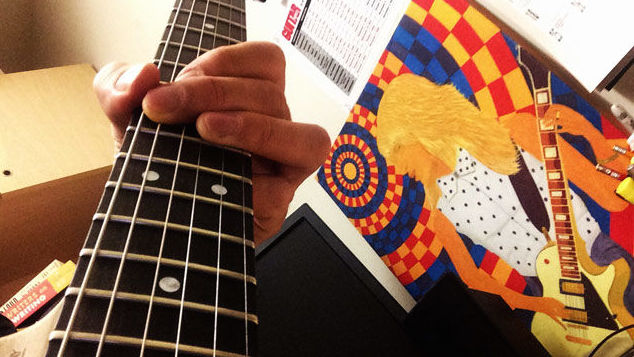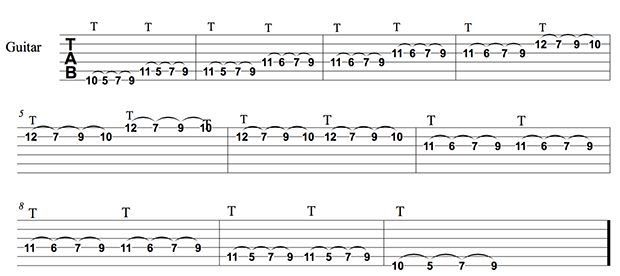Two-Hand Tapping Workout, Part 2: Diatonic Scales
Improve your tapping skills with this two-hand workout.

In this lesson, I'm going to show you a two-hand tapping workout based on the foundation of my previous lesson, "Diatonic Scale Workout: Increase Left-Hand Strength and Produce Great-Sounding Sequences."
If you're already comfortable with the seven positions of the diatonic three-note-per-string scales and the sequences discussed in this previous lesson, we'll take it to then next level.
We’ll use the A major scale at the fifth position as our example, but you'll want to make sure you can perform this routine in all seven positions of the major scale.
This workout starts with the A major scale ascending and descending, with the added element of our right hand, tapping an additional note normally found in the next position of the scale (EXAMPLE 1).

After this establishes the fingering for your left and right hands, the workout continues with a two-string sequence, where you play the “high note (right hand), then the first, second, third note (left hand)” tapping pattern across sixth and fifth strings. This pattern starts again on the fifth string, continues to the fourth string, then repeats in a similar fashion ascending across all six strings. Turn the direction around to descend (EXAMPLE 2).

The third part of the workout is a sequence that ascends in 12-note groups (three strings’ worth of tapped diatonic scale), then back a string, start on the D (fifth string) and ascend another 12 notes (three strings). Continue this pattern until you start the sequence on the G string, at which point you simply turn the pattern around and perform the sequence in reverse: from the high E string, you play the tapping pattern descending nine note (three strings), go back a string and start the pattern again on the B string, and again, continuing in the same fashion (EXAMPLE 3).

The fourth and final part of the tapping workout involves string skipping. Using the same tapping pattern—high note (right hand), then the first, second, third note (left hand)—as before, start on the low E string, skip the A string, play the pattern on the D string, go back to the A string and start the pattern again, then skip the D string, and play the tapping pattern on the G string. This pattern continues, gets turned around like before and then works its way back in reverse (EXAMPLE 4).

I like to string these four examples together, playing then back to back, without stopping. I find this forces me to think ahead, be able to change gears and mix things up in my regular playing more easily.
Once you're able to play these four elements back to back without any problems, try it with the other six major scale positions. Use a metronome to gauge your progress, and push yourself to play these at a faster tempo once they become comfortable.
Guitarist Adrian Galysh is a Los Angeles-based solo artist, session musician, composer and education coordinator for Guitar Center Lessons. He's the author of Progressive Guitar Warmups and Exercises. Adrian uses SIT Strings, Seymour Duncan pickups and effects, Brian Moore Guitars, Voodoo Lab and Morley pedals. For more information, visit him at AdrianGalysh.com.
Get The Pick Newsletter
All the latest guitar news, interviews, lessons, reviews, deals and more, direct to your inbox!









![Joe Bonamassa [left] wears a deep blue suit and polka-dotted shirt and plays his green refin Strat; the late Irish blues legend Rory Gallagher [right] screams and inflicts some punishment on his heavily worn number one Stratocaster.](https://cdn.mos.cms.futurecdn.net/cw28h7UBcTVfTLs7p7eiLe.jpg)
